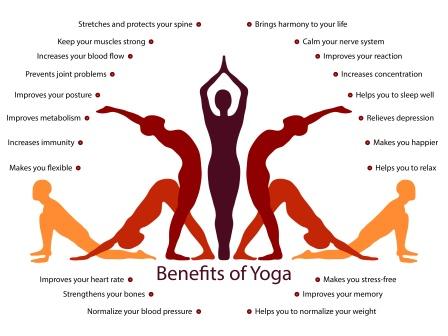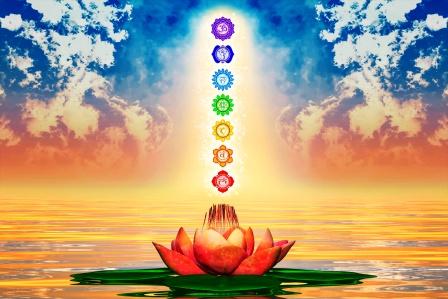Yoga Darshana: Introduction, History, Definition, Shat Karma, Benefits
Article by Dr Raghuram Y.S. MD (Ay) & Dr Manasa, B.A.M.S
Yoga is a big science by itself and a trend of the modern day world. It is a comprehensive method of psycho-somatic healing, an answer for many physical and mental problems, a method of identifying one’s serene self and peace of mind and a unique method of balancing and maintaining a rhythm between body and mind.Just like Ayurveda, Yoga too is a pride of Indian soil, having taken its origin from this divine land. Today, the modern world has accepted and adapted Yoga as one of the effective healing modalities. Extensive research works related to Yoga and the results of the same in healing many body-mind disorders have further justified the stand of Yoga in the world. It is a science of self-realisation.
Table of Contents
Goal of Yoga
Yoga word means union. Yoga means union with the object of knowledge. Such union alone is considered as true knowing. The person who practices Yoga is called Yogi. For Yogis, the object of knowledge is the universal spirit called Brahma. Thus, for a Yogi, the ultimate union with Brahma is the aim. This is also the goal of Yoga, knowing self, realising about self and union with greater universal soul.
The main aim of the human life is to achieve Purushartha Chatushtaya (4 important pursuits, aims or wealth of human life). They are –
- Dharma (Righteousness, Duty, Decree or Custom) – Dharma is art of many religious or spiritual beliefs that began in India. The eternal and inherent nature of reality regarded in Hinduism as cosmic law underlying right behaviour and social order. It is also defined as social custom regarded as a religious and moral duty.
- Artha – Wealth, pursuits of material wealth, meaning of life, sense, goal, purpose or essence
- Kama – Desires and ambitions (health, wealth, power, service, recognition, sexual needs)
- Moksha – Liberation or salvation
Yoga helps in achieving the goal of Purushartha Chatushtaya.
Read related: Four pursuits of life – Purushartha Chatushtaya
Yoga Shastra or the science of Yoga aims at establishing the physical, mental, ethical and philosophical values of the mankind.
Patanjali Yoga Darshana is said to be the oldest literature related to Yoga and is estimated to be composed around 200 BCE.

History of Yoga
The doctrines, principles and practice of Yoga had its origin from the Upanishad period. Upanishad has given the outlines of the essential practices of Yoga. Various references of Yoga are also found in Rig Veda, Yajur Veda and Bhagavad Gita. Sankhya and Yoga are the two main philosophies that have been accepted by Ayurveda.
These practices were elaborated and given a philosophical foundation in the Yoga Sutra of the Indian scholar Patanjali, who is traditionally regarded as the ‘founder of Yoga’ often called as ‘father of Yoga’. The classical reference is found in Yogasutra of Patanjali. The period of this work dates back to 3rd century B.C.
As a system of practice, Yoga has been one of the most influential features of Hinduism. Yoga’s strong influence can also be seen in Buddhism. Gradually, over a period of time, Yoga gripped over the whole world. As its knowledge spread all over the globe, it fascinated and won many followers among westerners. The trend and belief of Yoga has been going to peak levels along with the timeline of evolution of modern world and the whole world is seeking remedy and solace for many ailments in Yoga. Yoga is not disappointing as well!
Word derivation
Derivation of the word Yoga
The word ‘Yoga’ has its origin from a Sanskrit root ‘Yuj’.
‘Yu’ actually means ‘to unite’. At the same time, it also means ‘to separate’.
Yoga thus means ‘to unite with the real’ and ‘to get separated from the unreal’.
When the consonant ‘j’ is added to ‘yu’, it means energy or direction. Hence the real meaning of Yoga is discipline or integration. It is the practical application of Vedic teachings.
The word Yoga is derived from the root words ‘Yuj Samadhau’, ‘Rujir Yoge’ and ‘Yuj Samyamane’. When derived from these root words, the term Yoga is used in different senses and meanings.
Yoga is used in the below mentioned meanings –
- Samhanana – Integrity or co-existing, compactness (of body and mind)
- Upaya – Methods
- Dhyaana – Concentration or meditation
- Sangati – Association
- Yukti – Bringing things together, Arrangement, Associating (body and mind)
According to the opinion of Yoga experts, ‘Yoga is a method of aligning all the forces and energies of the body (shareera), mind (manas) and soul (jeevatma) and focusing them over the Paramatma (eternal soul from which we are all evolved and derived, God)’.
Yoga helps in unifying Jeevatma (lesser souls) with Paramatma (the greater soul from which we are derived), the disintegration and unification of microcosm into the macrocosm.
It is said that when we are born into the world, each of our soul gets separated from its creator, the Paramatma. Yoga helps our souls to unify with its master (Paramatma). Therefore, Yoga is called as Moksha Pravartaka i.e. provider of salvation or liberation.
When one practices Yoga on regular basis, he or she would be able to control the fluctuations occurring in the Manas (mind), Buddhi (intellect) and Ahankara (egoism). As a result, the Yogi (one who practices Yoga) experiences a status of internal bliss or true and unadulterated happiness, which is pure and uninflected by the clutches of indriyas (senses). This means to tell that this internal bliss obtained by Yoga will be beyond the perception of the realms of senses (ateendriya) and will be detached from the sensory desires and ambitions which are the mainstays of all the grief (dukha). This is the greatest pursuit, greatest achievement of one’s life. When one reaches this stage of eternal bliss, he or she is no longer afflicted by the gravest of grieves.
Read related: Health Benefits Of Yoga: Mind And Body
Yoga is a science which deals with all aspects of life. Swami Satyananda Saraswati, the founder of ‘Bihar School of Yoga’ explains Yoga as “Yoga is not an ancient myth buried in oblivion. It is the most valuable inheritance of the present. It is the essential need of today and the culture of tomorrow.” Sri Arabindo defines yoga as, “It is the methodological effort towards the self-perfection by the development of potentialities which are latent in the individual.”
Yoga is the science of right living and as such is intended to be incorporated in daily life. It works on all aspects of the person: the physical, vital, mental, emotional, psychic and spiritual.
The word yoga means unity or oneness and is derived from the Sanskrit word yuj which means to join. This unity of joining is described in spiritual terms as the union of the individual consciousness with the universal consciousness. Yoga is a means of balancing and harmonizing the body mind and emotions. It aims at bringing the different bodily functions into perfect coordination so that they work for the well being of the whole body. This can be done through the regular practice of Asana, Pranayama, Mudra, Bandha, Dhyana, Shatkarma.
Read related: How To Do Pranayama – A Simple Pranayama Technique
Acharya Gheranda in his treatise explains the importance of yoga as “yoga is the superior strength in the world than anything; knowledge is the greatest friend of an individual; whereas one’s ego is greatest enemy and the illusion is considered to be the deadliest noose.”
Aim and objective of Yoga
The main aim of Yoga is to permanently detach one from his or her vedana (pain, worry, grief).
Yoga involves meditation, patience, silence and peace. Yoga is also called Yajna, which means sacrifice or surrender. Yoga, thus means to sacrifice the outer objects and objectives so as to achieve the inner or higher objects or objectives.
Yoga directly touches the eternal point of human’s mind and thus improves the consciousness of human being. It is a unique science by itself; it combines science and spiritual activities under one roof.
Yoga tries to stabilize the activity of all the five sense organs, which helps in concentration, self-control and meditation. According to Patanjali, Yoga is a stage in which all the activities of the mind get stabilized.
According to Bhagavad Gita, Yoga makes the person free from tensions and pains. It helps to fix one’s mind on God. The withdrawal of sense organs from worldly pleasure objects is useful in attaining this purpose. Yoga recommends and indicates maximum coordination of energy towards transformation or liberation.
Yoga emphasizes and helps in realizing the ultimate fact of philosophy by means of steady and persistent meditation.
The aim of Yoga is mainly to achieve the psycho-spiritual liberation but it has not neglected the importance of maintaining health in the process of pursuing it.
Both the sciences of Yoga and Ayurveda have evolved from the same philosophy, culture and country. They look at the human being from the same holistic angle, in a comprehensive way.
Yogaroodha
Yogarudha is the name of a person who has controlled his mind, intellect and egoism i.e. a self-controlled person. This person has also detached himself from the attraction and magnetism of the sense objects, which are the prime sources for all types of grief and worries.
These include
Shabda (sense object of ear, i.e. sound),
Sparsha (sense object of skin, i.e. touch),
Rupa (sense object of eye, i.e. vision),
Rasa (sense object of the tongue, i.e. taste) and
Gandha (sense object of nose, i.e. smell).
Characters of Yukta
Below said are the qualities of Yukta –
Jgnana Vijgnaana Trupta – Well versed in all sorts of knowledge of Shastras (classics, theory) and Adhyatma (philosophical knowledge)
Aatma Kootastho – Clean consciousness (good soul)
Vijitendriyaha – he, who has conquered and controlled his senses,
Sama Loshta Ashma Kanchanaha – One who sees no difference between mud, stone and gold (he considers everything alike)
The person adorned with above said qualities is called Yukta, which means the person who is fit to obtain salvation. These qualities come on regular practice of Yoga.
Definition of Yoga
According to Patanjali, who is often considered as father of Yoga, Yoga is defined as Chitta Vritti Nirodha. Chitta Vritti means the activities of the mind. Nirodha means controlling or blocking. In short, controlling the fluctuant and uncontrolled activities of the mind and channelizing it is called Yoga. Control over the mind and mind activities are often equated to the control over self. Chitta Vritti Nirodha also means the control over the sense organs and their subjects, which are again under the control and supervision of the mind.
Streams of yoga
There are various schools (streams) of yoga explained in different classical literature. They are
Raja Yoga,
Hatha yoga,
Jnana Yoga,
Bhakti Yoga,
Karma Yoga,
Mantra Yoga and
Laya Yoga.
The streams of yoga are mainly classified into
- Bhavana Yoga
- Prana Samyamana Yoga
Bhavana yoga includes karma yoga, bhakti yoga and jnana yoga.
Prana Samyamana Yoga includes raja yoga, hathayoga, kundalini yoga, mantra yoga, laya yoga.
Karma yoga, bhakti yoga, jnana yoga are explained in 18 chapters of Bhagavat Gita in 6 chapters each.
Yoga variants
Different Methods or Important variants of Yoga
The prefix against the term Yoga points out the aim, purpose and objective of that Yoga. The term Yoga has been used with many terms and the combined terms denote the objective of that Yoga. The different forms of Yoga are –
Hatha Yoga
Hatha Yoga and Raja Yoga are two most important variants of Yoga. If Yoga is a river, Hatha and Raja Yoga could be considered as two streams of the same river.
Hatha Yoga is oriented towards physical health. It aims at making the physical body strong, integrated, and composed, disease free and immune. Hatha Yoga prepares the body to adapt the Adhyatmik (philosophical) way of living i.e. Hatha Yoga prepares one for Raja Yoga.
Hathayoga is explained by Matsyendranath in Hathayoga Pradika as the tough practice among all the streams of yoga. Hathayoga is said to be the ladder for raja yoga. Rajayoga follows 8 principles whereas hathayoga follows sapta sadhanas i.e. ‘Shat karma’ (6 cleansing procedure), Asana, Mudra, Pratyahara, Pranayama, Dhyana and Samadhi.
All of these techniques purify the body, mind and energy systems to prepare the ground for ultimate experience of cosmic consciousness.
Hatha Yoga comprises of 6 important measures which help in cleansing the body from within. They are called Shat Karmas.
Shat Karmas:
- Nauli Karma – Exercise for abdominal muscles and abdominal viscera
- Dhauti Karma – It is a method of cleansing the stomach mainly by induced emesis (vomiting). It is of 2 types i.e. Vastra Dhauti and Jala Dhauti
- Vasti Karma – It is a method of cleansing the colon and is of two types i.e. Pavana Vasti and Jala Vasti
- Neti Karma – It is a method of cleansing the nose and upper respiratory tract. It is of 2 types i.e. Jala Neti and Sootra Neti
- Kapalabhati – It is a method of controlling the breathing phenomenon by intense inspiration and expiration of air, similar to Pranayama
- Trataka – It is the method of focusing the vision on any minute object and constantly seeing it until the eyes start tearing. Trataka is also of 3 types i.e. Aantara Trataka, Bahya Trataka and Madhya Trataka.
Read related: Hatha Yoga and Shat Karmas: Benefits, Precautions
With constant practice of these Shat Karmas mentioned in Hatha Yoga, the channels of the body are cleansed and purified (Sroto Shuddhi). With this the body becomes strong and composed.
For comprehensive health, Hatha Yoga has enumerated 12 types of Mudras (postures), 10 types of Mahamudras (great postures) and 3 types of Bandha (method of blocking the opening of Sushumna or spinal column and provoking the depressed Kundalini Shakti, art of stimulating the energies in the spinal column from the tip to the origin).
Read related: Chakra – Kundalini: Introduction, Meaning, Types, Location, Ayurveda View
Raja Yoga
Raja Yoga is the method of achieving comprehensive mental health and composure as is Hatha Yoga for physical well being. Hatha Yoga strengthens and fortifies the physical body and prepares it for Raja Yoga. Raja Yoga on the other hand strengthens and fortifies the mind, makes it healthy and helps one to traverse in the pathway of Adhyatma (philosophical living). It invokes spiritual and philosophical thoughts in the mind and helps one to gain control over the mind and senses.
Raja Yoga is also called as Astanga Yoga was introduced by Acharya Patanjali.
It involves 8 principles or steps like
Yama (fixed principles or discipline),
Niyama (rules and regulations),
Asana (posture),
Pranayama (breathing regulations),
Pratyahara (withdrawal of senses),
Dharana (art of concentration),
Dhyana(meditation), and
Samadhi(contemplation).
Patanjali Yoga Darshana, Ashtanga Yoga
As far as Yoga is considered, Patanjali Yoga Darshana and Ashtanga Yoga proposed by Acharya Patanjali have been traditionally and evolutionally accepted as original Yoga and form the foundation and mainstays of unadulterated Yoga.
The philosophical school of Patanjali was called Yoga Darshana. It was one of the Darshana Shastras. Patanjali’s Yoga Darshana advocated Ashtanga Yoga or 8 limbs of Yoga (8 sections, branches, and parts) for those who successfully want to attain Yoga Sadhana (ultimate control over the mind and senses).
The classical Yoga as defined by Patanjali is an eight stages-process of spiritual development. The Ashtanga Yoga comprises of the below mentioned 8 limbs –
Yama – These are the guidelines one needs to follow by deeds, verbally and mentally so as to promote harmony of oneself in the society. They are 5 in number i.e.
- Ahimsa – Non violence
- Satya – Truth
- Asteya – Freedom from hoarding
- Brahmacharya – Abstinence from sex, control of sexual energy
- Aparigraha – Abstinence from greed
Niyama – These are the five principles one need to follow for personal and spiritual discipline. They are as below mentioned –
- Shaucha – Purity
- Santosha – Happiness, contentment
- Tapas – Purification
- Swadhyaya – Self observation through reflections on the scriptures
- Ishwara Pranidhana – Devotion to God
Asana – Comfortable seating or placement without being mobilized is called Asana. Yoga postures which are performed in a particular manner by placing oneself in a comfortable position or posture are called Asanas. In this, the regular bodily movements are avoided by sitting in a comfortable posture and focusing one’s mind and consciousness on God. This is said to provide maximum benefits of Asana. Asanas are said to provide comfort and relaxation to mind and body, stabilize and strengthen the muscles, develop concentration of mind and strengthen the body.
Read related: 24 Stress Management Tips: Pranayama, Meditation, Lifestyle Changes
Pranayama – Pranayama is a technique of controlling the breathing phenomenon so as to control the Prana or vital air or life force. This enables the practitioner of Pranayama to develop an inward focus while living a full productive lifestyle.
Pranayama is of three types, i.e.
- Rechaka or Bahya Vritti Pranayama (holding and controlling the breathe outside the body),
- Pooraka or Aabhyantara Vritti Pranayama (holding and controlling the breathe inside the body) and
- Stambha Vritti Pranayama (blocking the Prana Vayu at the place where it is located, following its normal course i.e. either inside or outside the body)
Pratyahara – Pratyahara is a method of withdrawal of the mind from the senses. It enables one to keep self attached from the objects of enjoyment or worldly pleasure which are experienced by the sense organs and mind. Pratyahara helps in keeping the senses attached from the mind and hence the mind doesn’t experience pleasure. This also enables one to control the mind and senses.
Dharana – Dharana means focusing the mind over an object or subject so as to develop or inculcate concentration is called Dharana.
Dhyana – Dhyana means meditation. This involves focusing the mind and concentrating on meditation.
Samadhi – Samadhi means unity of the mind with its object of meditation. In this practice, the form of object or objects is directly experienced to be of a spiritual nature. Thus Samadhi involves unification of Manas (mind) with Atma (soul).
Read related: Meditation By Watching Mind: Stages, Method, Benefits

Karma Yoga
Karma Yoga means service or selfless work. It includes all the actions or activities done with an attitude of detachment for the fruits of the action. This means that, when you do some activities or actions without expecting any fruits or benefits of such actions, with pure motive of giving selfless service, it is called Karma Yoga. Attachment is the basis of all misery and pain. If selfless work is done, one gains freedom from all misery and pain. The principal source book for practice and philosophy related to Karma Yoga is the classic epic, Bhagavad Gita.

Bhakti Yoga
Bhakti means devotion and unconditional surrendering to God, or the supreme soul. This Yoga teaches you the method of praying and worshiping God with love and affection. With this type of Yoga, the man learns to gain control over emotional instabilities and ultimately love the entire world, selflessly. The reference work on this type of Yoga is Narada’s ‘Bhakti Sutras’.

Jnana Yoga
Jnana means unadulterated knowledge in its purest form. Jnana Yoga helps in acquiring the knowledge through proper reasoning. This form of Yoga teaches the process of right reasoning and inquiry leading to thought-free mediation. With practice of Jnana Yoga, one learns the method of approaching the ultimate truth with acuity of mind. The reference work on Jnana Yoga can be found in Swami Vivekananda’s Jnana Yoga.

Kundalini Yoga and Tantra Yoga
Kundalini shakti is the ultimate psychic energy of transformation. It is said to be located at the base of the spine in a concealed form. Kundalini Yoga teaches you the method of gaining control over the dormant power of Kundalini. Kundalini awakening is done gradually by moving the Prana through the central canal (Sushumna) purifying the seven Chakras or spinning wheels of psychic energy fields around us.
Benefits of Yoga
Yoga bestows good body-mind health. It helps in discovering self and living a better life, life of good values and morals. It helps in detoxification of the body, enhances immunity, strengthens body tissues and viscera, improves circulation, prolongs life and life quality, improves fitness, delays ageing, provides body-mind equilibrium, enhances the functioning capacity of organs and tissues, prevents diseases and damages and contributes towards comprehensive personal and community health.
Selection of client suitable for Yoga practice, Rules and Regulations of Yoga
Like any activity or assignment, Yoga too should be practiced and followed abiding to certain rules and regulations. This is to achieve optimum benefits of Yoga. They include –
Finding the eligible candidate for Yoga after thorough screening and examination, including age, sex, food, health, lifestyle, attitude, celibacy, dedication and preparedness of the client and his or her habits should be analyzed. The person seeking Yoga should have flawless qualities and should fit into each term and condition and abide to every rule which permits him to get trained in Yoga.
Preliminary examination of the client including examination of blood pressure, heart rate, pulse, weight etc should be done before hand and decided if the person is physically and mentally fit to undergo Yoga.
Physical and mental attitude and preparedness, postures and body composure etc should be examined.
The food patterns, the wholesome practices which should be followed (including food and lifestyle) and unwholesome practices which need to be avoided (including food and lifestyle) should be told to the client beforehand. Likewise the rules and regulations related to dressing, behavior, attitude, purity of body, mind and thoughts, celibacy, and time of doing Yoga should be thoroughly explained to the client seeking Yoga training.
Click to Consult Dr Raghuram Y.S. MD (Ayu)
Hatha Yoga
The term Hatha is split into two words ‘Ha’ and ‘Tha’.
‘Ha’ means Sun
‘Tha’ means Moon
Hatha Yoga means unifying Ha and Tha i.e. unifying the energies of the Sun and Moon and to attain a balance between them.
According to a treatise named Hatha Yoga Pradeepika – ‘That source which helps in quickly opening the doors of Moksha – salvation is called Hatha Yoga’.
This means that Hatha Yoga helps in attaining Moksha, which is the ultimate goal of our life and incarnation.
Laya Yoga
Laya yoga is an ancient form of meditation, with concentration on energy centres or ‘chakras’. Sage Gorakshnatha, an ancient sage of Nepal, and a disciple of Matsyendranath is the founder of Laya yoga.
Laya yoga attempts to locate these energy centres and channelise them through meditation.
Laya yoga is of two types –
1. Prana Laya – Breath (prana) should be held in the braharandra (anatomically located at centre of the cranium, in between sagital and coronal sutures of the skull).
2. Mano Laya – Mind (manas) should be one with the soul (atma).
Benefits:
The residual inevitable results as a result of former deeds (in previous life or the present life) gets exhausted.
The mind (manas) and memory (smruti) becomes free from inevitable results of the previous deeds.
Salvation or knowledge about the soul (Atma) is achieved.
Kundalini Yoga
Here, practice of 10 types of Mudras (postures) have been explained –
1. Maha Mudra
2. Maha Bandha
3. Maha Vedha
4. Khechari Mudra
5. Udhyaanu Bandhan
6. Moola Bandha
7. Jaalandhara Bandha
8. Vipareetakarini
9. Vajroli
10. Shakti chaalana
Mantra Yoga
Mantra means Vedic hymns, incantations or prayers.
Mantra yoga is a type of yoga that uses Vedic hymns (mantras) to control the sense organs and mind . It is based on focusing on sound, duration and number of repetitions of the hymns. It aims at uniting the soul with the supreme spirit (paramatma) which is known as salvation.
Read related: Hymns In Ayurveda Samhitas For Fever
Bhakti Yoga
The Sanskrit word ‘bhakti’ comes from the root ‘bhaj’, which means ‘to adore or worship God.’
Bhakti yoga means worshipping the God.
It is of 9 types:
1. Shravana – listening to the hymns
2. Keertana – chanting hymns
3. Smarana – remembering the Divine by constantly meditating upon its name and form.
4. Padasevana – service at the feet of the Divine which includes the practice of Karma Yoga (selfless devotion)
5. Archana – ritual worship of the Divine through practices such as pooja (deity worship), and homa (fire offering).
6. Vandana – adoration and worship of the Divine.
7. Daasya – devotion, serving the will of God.
8. Sakhya – relationship established between the Divine and the devotee.
9. Atma nivedana –surrendering of the self to the Divine.
Read related: Sankhya Darshana and Ayurveda: Relation and Similarities








